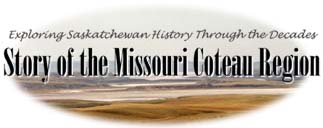 |
![]() Land
would be divided into townships that were 6 miles square (9.6 km); each township
contained thirty-six sections of 640 acres. Each section was divided into four
quarters with each quarter having 160 acres. Sections eleven and twenty-nine
in every township were reserved as school land, which would be sold later to
homesteaders that had become established; profits were to be used for the purpose
of erecting a public school.
Land
would be divided into townships that were 6 miles square (9.6 km); each township
contained thirty-six sections of 640 acres. Each section was divided into four
quarters with each quarter having 160 acres. Sections eleven and twenty-nine
in every township were reserved as school land, which would be sold later to
homesteaders that had become established; profits were to be used for the purpose
of erecting a public school.
The following table demonstrates the rapid expansion of Saskatchewan's population.
Saskatchewan's Population
|
Year
|
Total Population
|
British
|
German
|
French
|
Scandinavian
|
Russian and Ukrainian
|
Other East Europe
|
Native Indian
|
Other
|
||||||||
| Total |
%
|
Total | % |
Total
|
% | Total | % | Total | % | Total | % | Total | % | Total | % | ||
| 1881 |
19,114
|
2,052
|
10.7 |
21
|
0.1
|
17
|
10.9
|
17
|
0.1
|
0
|
0.0
|
--
|
--
|
14,914
|
78.0
|
31
|
0.2 |
| 1885 |
32,079
|
16,208
|
50.5 |
299
|
0.9
|
73
|
2.1
|
73
|
0.2
|
15
|
0.1
|
--
|
--
|
14,288
|
44.5
|
551
|
1.7 |
| 1901 |
91,279
|
40,094
|
43.9 |
11,743
|
12.9
|
1,452
|
2.9
|
1,452
|
1.6
|
11,675
|
12.8
|
4,791
|
5.2
|
17,734
|
19.4
|
1,156
|
1.3 |
| 1911 |
492,432
|
251,010
|
51.0 |
68,628
|
13.9
|
33,991
|
4.7
|
33,991
|
6.9
|
18,413
|
3.7
|
47,742
|
9.7
|
11,718
|
2.4
|
37,649
|
7.7 |
| 1916 |
647,835
|
353,098
|
54.5 |
77,109
|
11.9
|
49,708
|
4.9
|
49,708
|
7.7
|
33,662
|
5.2
|
68,536
|
10.6
|
10,902
|
1.7
|
22,754
|
3.5 |
| 1921 |
757,510
|
400,416
|
52.9 |
68,202
|
9.0
|
58,382
|
5.6
|
58,382
|
7.7
|
73,440
|
9.7
|
65,978
|
8.7
|
12,914
|
1.7
|
36,026
|
4.7 |
| 1926 |
820,738
|
416,721
|
50.8 |
96,498
|
11.8
|
63,370
|
5.7
|
63,370
|
7.7
|
87,682
|
10.7
|
57,682
|
7.0
|
13,001
|
1.6
|
38,754
|
4.7 |
| 1931 |
921,785
|
437,836
|
47.5 |
129,232
|
14.0
|
72,684
|
5.5
|
72,684
|
7.9
|
98,821
|
10.7
|
72,783
|
7.9
|
15,268
|
1.7
|
44,461
|
4.8 |
| 1936 |
931,547
|
427,088
|
45.9 |
165,549
|
17.8
|
72,028
|
5.4
|
72,028
|
7.7
|
98,117
|
10.5
|
60,517
|
6.5
|
21,394
|
2.3
|
36,559
|
3.9 |
| 1941 |
895,992
|
397,905
|
44.4 |
130,258
|
14.5
|
68,806
|
5.7
|
68,806
|
7.7
|
105,710
|
11.8
|
67,169
|
7.5
|
22,548
|
2.5
|
53,066
|
5.9 |
| 1951 |
831,728
|
351,905
|
42.3 |
135,584
|
16.3
|
62,439
|
6.2
|
62,439
|
7.5
|
97,852
|
11.8
|
58,298
|
7.0
|
22,253
|
2.7
|
51,510
|
6.2 |
| 1961 |
925,181
|
373,482
|
40.4 |
158,209
|
17.1
|
59,824
|
6.5
|
67,553
|
7.3
|
101,332
|
10.9
|
79,395
|
8.6
|
30,630
|
3.3
|
54,758
|
5.9 |
| 1971 |
926,245
|
390,190
|
42.1
|
180,095
|
19.4
|
56,200
|
6.1
|
59,105
|
6.4
|
95,995
|
10.4
|
57,160
|
6.1
|
40,550
|
4.4
|
46,950
|
5.1 |
Statistics from Saskatchewan A History by John H Archer.